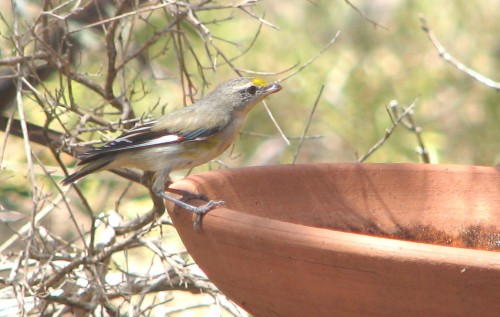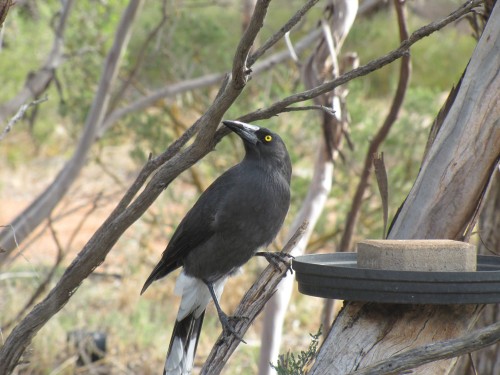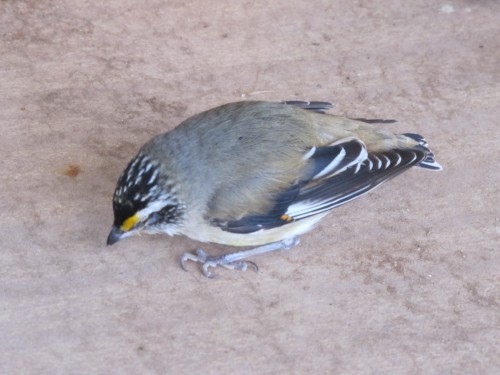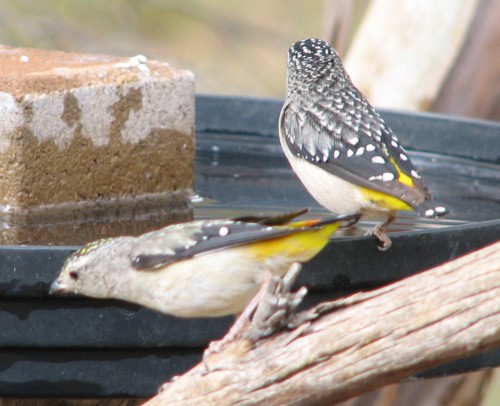Pardalotes up close
Yesterday I was in the garden looking at one of the bushes coming into flower. Without any warning, two juvenile Striated Pardalotes landed on the fence not much more than a metre from where I stood. They looked me over for about 30 seconds before flying off.
Of course, like so many other encounters with birds, I didn’t have my camera with me because I had gone into the garden to check on the swimming pool, not thinking of seeing any birds up close.
Instead, I have posted a photo of the same species taken at one of our bird baths some time ago.
A sudden awakening
A few mornings ago I was just emerging from a good night’s sleep when there was a very loud bang on our bedroom window. Light was just beginning to filter into the room past the edges of our curtains. After this sudden noise there was no hope of dreaming on – or of sleeping in for a while.
In my bare feet I padded across to the window and drew the curtains, expecting to see a half-dazed bird on the pavers of the path outside.
Nothing. After showering and dressing I went into the garden to investigate. Still nothing. But the bird which had crashed into our window had left two nasty after-effects.
Streaked across the glass was a huge mess where the bird had defecated on impact.
And the glass pane was neatly cracked – diagonally from one top corner to the opposite bottom corner.
We frequently have birds crash into our windows; it probably happens every few weeks. Usually they are just stunned for a few minutes before they fly off, wiser perhaps for the experience. Several times a year – perhaps only once or twice – a bird will be so badly hurt that it is killed on impact. Usually it is the smaller birds such as the pardalotes.
Collisions like this happen all over the world. The birds see a reflection of some trees or a park or a garden in the window and they assume that they can fly right on through – until they come to a sudden halt when they hit the glass. There is very little one can do to prevent this unfortunately.
On this occasion, however, there remained a puzzle. Which species had caused such a devastating impact on our window – enough to crack it so thoroughly? My first thought was a baby magpie just learning to fly. We have several of them around at present. Then I thought it could have been a Little Raven. Tough critters – but we haven’t seen many of those around recently.
This morning I realised that it could have been a Grey Currawong. Several have been hanging around the garden recently and with their enormous beak the impact could have been caused by one of them.
Unless they start talking to me, I guess I’ll never know!
Ouch! That hurt!
This morning I was sitting in our sun room doing some reading while I had a cuppa. There was a sudden thud on the window near me – a sound we hear a little too frequently.
Window strike.
Every few days we hear a bang on one of our windows. Unfortunately, some of our garden birds see the reflection of the garden in the glass of one of our windows, and mistakenly thinking they can fly straight ahead, come to a sudden, head splitting halt. Most birds suffer mild concussion briefly before flying off, a little sadder but hopefully wiser for the experience. The occasional one does not survive the impact. [Sigh].
This little Striated Pardalote shown in today’s photo was the latest hapless victim. I picked him up and cradled him in my hands for a few minutes, showing off his beautiful colours to some visitors who happened to arrive during my rescue. I placed the bird on an outside table, took several photos and left him to recover. Within minutes it had flown off.
I hope his headache didn’t last long.
Further reading
Angry birds in our garden
Last week I wrote about the young Grey Currawongs being fed by the adults in our garden. They are still hanging around and squawking noisily whenever they get hungry – which seems to be most of the time.
Yesterday morning I was doing some reading in our sun room when a sudden screeching noise outside interrupted my thoughts. I grabbed the binoculars (but not the camera, alas) and raced outside. High up in the sky above our house a Little Eagle was soaring around on the gentle breeze, obviously looking for something to eat for lunch.
The eagle seemed oblivious to the fact that both currawong parents were attacking it, screeching loudly in order to chase away the offending predator. Slowly, almost nonchalantly, the eagle glided away out of sight and the currawongs calmed down and resumed feeding the young ones., and peace resumed in the garden.
More angry birds
The currawongs are not the only angry birds resident in our garden. The Australian Magpies chase off the Grey Currawongs and the White-winged choughs, the Willie Wagtails are constantly attacking all three already mentioned and the Red Wattlebirds appear to have a distinct dislike towards anything with wings, including the hapless tiny Pardalotes. This latter conflict is a real miss-matched war: wattlebirds are bout 36cm long compared with the pardalotes weighing in at only 8cm. I reckon the wattlebirds are the big bullies in our little patch.
Pardalote up close
My regular daily walk takes me along a road bordering our five acre property and then towards a nearby railway line which runs from Adelaide to Melbourne. This road has a reasonable collection of remnant mallee vegetation between the road and the fences along nearby farms and other properties.
On a recent afternoon walk my attention was caught by the movement of a small bird in the roadside vegetation. I stopped to have a closer look, edging to within a metre. A Spotted Pardalote was feeding at a height of about a metre. Totally ignoring me it continued to feed while I watched up close. I admire these beautiful little birds whenever I see them, and their cheerful chirping in our garden is always welcome.
I usually don’t take my camera on these walks, so I’ve included a photo I took some time ago of two of this species visiting one of our birdbaths in our garden.
Perhaps I should get into the habit of taking my camera on my walks because I’ve missed some excellent photo opportunities in recent weeks.






